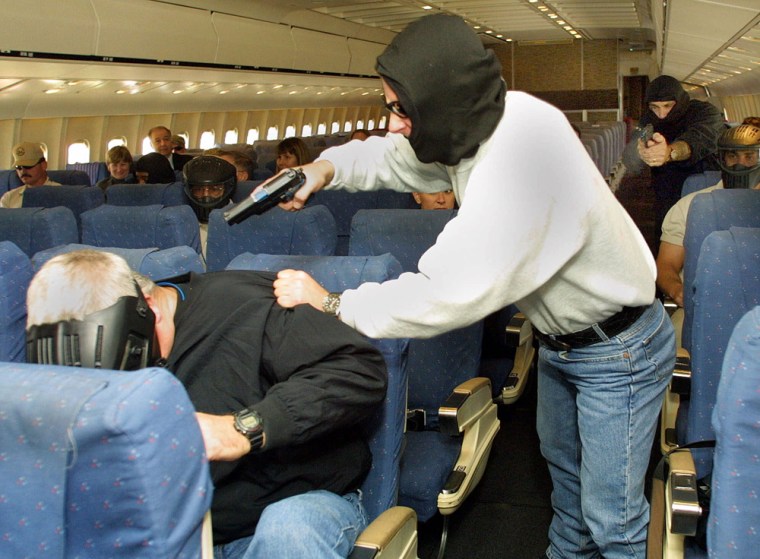The Federal Air Marshal Service is set to begin hiring for the first time since the agency ramped up dramatically in the immediate aftermath of the terrorist attacks of Sept. 11, 2001, MSNBC.com has learned. The hiring announcement could come as soon as next week and would add badly needed new recruits to a rank-and-file membership that has been steadily declining.
“We hope that very soon, within the next week perhaps, and I would hope that no later than a month, to be announcing positions for federal air marshals nationwide,” said David Adams, a spokesman for the Federal Air Marshal Service. “We’ve been working to write a new job description,” Adams said. “And we’re in the process of vetting the requirements of the job through internal channels.”
On Sept. 11, 2001, there were only 33 air marshals in federal service; within months that number had jumped to thousands (the actual number is classified) when Congress reinvigorated the service by authorizing a massive buildup of the agency, which was first created in the 1970’s after a rash of airline hijackings.
Air marshals are armed, inconspicuous agents that fly on commercial airlines. They are trained and authorized to use deadly force, if needed, to thwart potential hijackings.
Adams said the aim of the new hiring push will be to return the air marshal corps to its congressionally mandated level, though he said that process will "come in stages" and not in a single round of hiring. Adams declined to say how many new hires the service expects to hire this year or in how many stages.
Rank-and-file air marshals have seen their numbers dwindle steadily at an attrition rate of about 6.5 percent per year, about average for a government law enforcement agency, with only 100 new recruits brought on board since the agency’s initial round of hiring in 2001. In addition, air marshals now spend time on Joint Terrorism Task Forces, a move that further reduces the number available for flight duty.
Meanwhile, international flights covered by air marshals also reduce the number of domestic flights they are on. “Each additional international mission results in approximately four fewer domestic missions,” that an air marshal can fly, agency officials told investigators from the Government Accountability Office last year.
Even at full strength, the air marshals can only cover a fraction of the nation’s estimated 28,000 daily commercial flights. Officials from the Air Marshal Service have refuted published reports that its current strength allows it to cover only three or four percent of the nation’s commercial flights. Agency Director Thomas Quinn, while not providing specifics, previously told MSNBC.com that the agency covers “more than five percent” of the nation’s daily flights.
A complex threat matrix, based on intelligence and vulnerability reports, determines what flights air marshals will cover. Some airports, such as those in New York and Washington, D.C., considered to be at higher risk for terrorism, carry a much higher percentage of air marshals on flights than other airports, according to agency officials.
Costly new recruits
But the news of job openings comes at a cost. During the initial round of hiring, the air marshals developed a database of more than 200,000 job applicants. The agency filled its ranks from that initial list; however, it took the further step of processing, interviewing and performing background check investigations and clearing for hire at least 504 additional candidates, according to a Department of Homeland Security Inspector General report.
The initial applicant database, however, was abolished in Feb. of 2003, Adams said. And the list of “qualified applicants” will soon suffer the same fate, despite the time and money that went into clearing all the persons on that list.
Adams said the old applicant database, developed under outdated Federal Aviation Administration guidelines, had to be abolished because the new air marshal job description has sufficiently changed and that it will require different skills and backgrounds. In addition, Adams noted any background checks done two years ago for those on the qualified list were now outdated and would need to be done again, thus negating their previous qualified for hire status.
News that the “golden list,” as some prospective air marshals on that waiting list called it, would be negated drew harsh criticism.
“I think it’s a sham,” said one potential candidate who requested anonymity. “I’ve been waiting for two years, just waiting, like treading water or something, hoping I’d get a call any day now,” said the potential candidate who is a police officer in a major metropolitan city. “This news is very disappointing, I just don’t understand why they’d waste all that effort and taxpayer money.”
A private firm, Avue, has been given a $1 million contract to help facilitate the hiring process, Adams said. This was done “to help speed up the process and get us a most eligible list of candidates,” Adams said.
The air marshals have struggled with tight budgets and declining force numbers for years. Originally under the umbrella of the Transportation Security Administration, the agency was transferred to Immigration and Customs Enforcement division of Homeland Security because of that agency’s strong law enforcement ties.
ICE agents have been cross-trained for emergency duty as air marshals in the event of a crisis. In addition, the air marshals have a “force multiplier” strategy in place that calls for other government law enforcement agencies, such as the Secret Service, FBI and DEA, to share flight info about their agents with the air marshals. That way, during a high terrorism alert situation air marshals can be deployed on other flights that have no armed federal agents on board.
